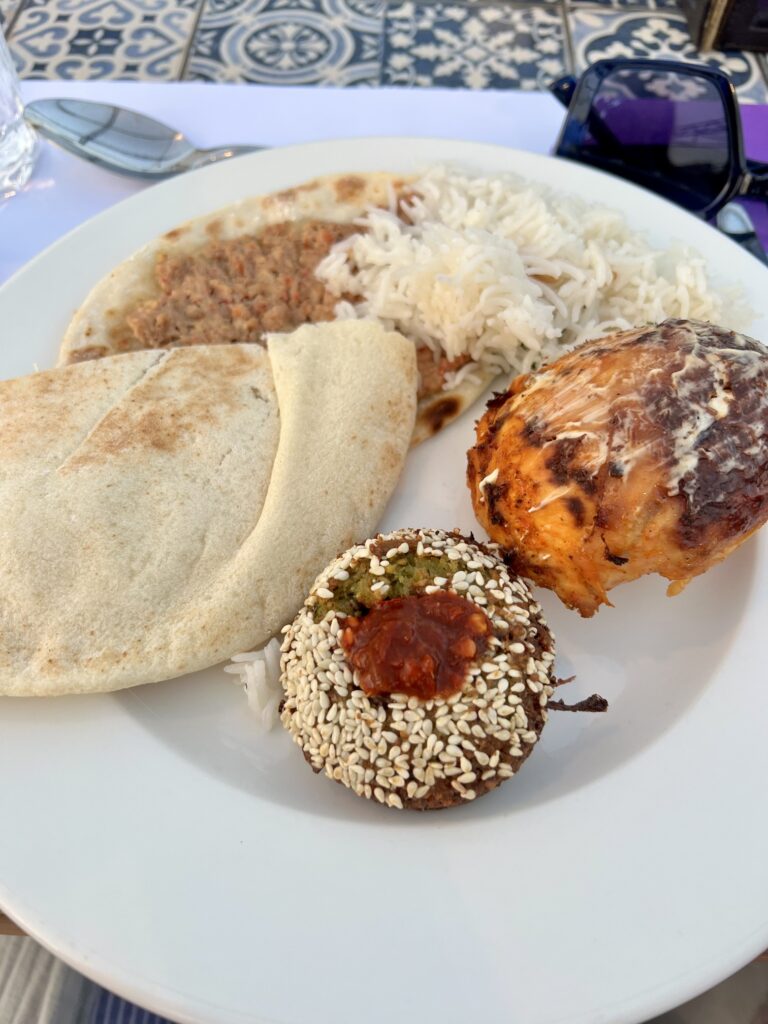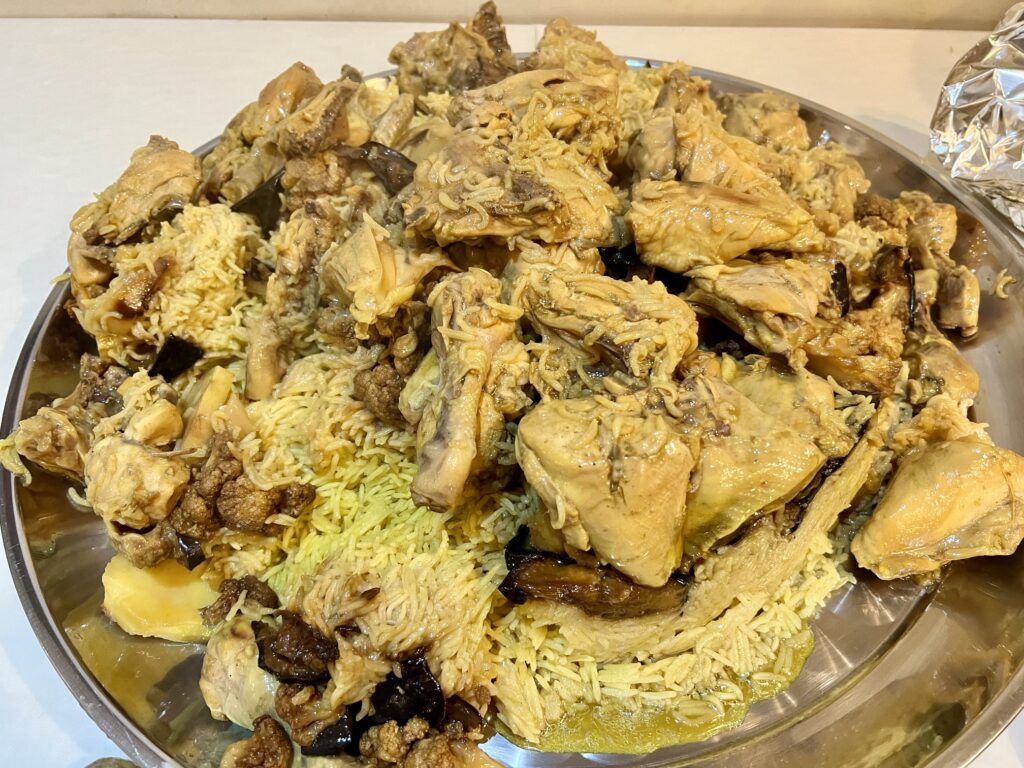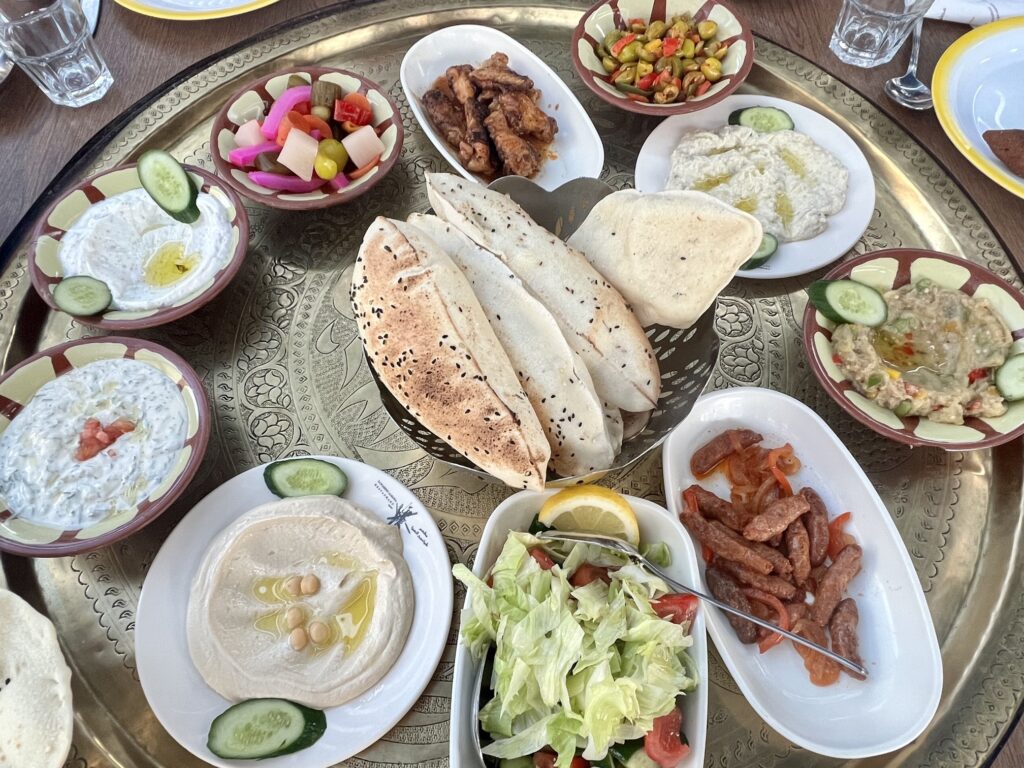
Tastes of Jordan: What Jordanian Food to Try in Jordan
 September 24
September 24
 14 min read
14 min read

Tastes of Jordan: What Jordanian Food to Try in Jordan- Key Highlights
- Embark on a culinary adventure through Jordan, savoring its rich and diverse cuisine, influenced by Levantine, Middle Eastern, and Bedouin traditions.
- Indulge in iconic dishes like Mansaf, Jordan’s national dish, a flavorful lamb dish cooked with jameed (fermented yogurt).
- Experience the vibrant street food scene with must-tries like Falafel, Shawarma, and fresh fruit juices. Don’t miss out on the art of Mezze, a selection of small dishes perfect for sharing.
- Immerse yourself in Jordanian hospitality as you savor traditional meals, often served with generous portions and warm welcomes.
- Complete your culinary journey by indulging in sweet treats like Knafeh, a delightful pastry soaked in sweet syrup, for a truly Jordanian culinary experience.
Introduction
Welcome to a tasty journey in the Middle East! Jordanian cuisine combines flavors from Levantine traditions and nomadic influences, with some dishes having roots in Egypt. This mix creates many delicious tastes that will excite your taste buds. The food in Jordan uses fresh ingredients and aromatic spices. The country offers a rich and varied culinary experience that reflects its long history. Get ready to enjoy the special flavors of Jordan. In the “Tastes of Jordan: What Jordanian Food to Try in Jordan,” I will show you the 10 must-try authentic Jordanian foods.
Exploring the Authentic Flavors of Jordan: 10 Must-Try Dishes
Jordan’s food scene is vibrant and welcoming. It reflects the country’s warm hospitality and rich culture. You are set to enjoy a delicious journey. Each bite tells a meaningful story, and every meal is a celebration of tasty flavors. If you love trying new foods or prefer classic comfort dishes, our guide is perfect for you. We will show you the top dishes that highlight the best of Jordanian cuisine.
Mansaf
No visit to Jordan is complete without trying Mansaf, the country’s favorite national dish. This dish shows the Bedouin culture and their way of welcoming guests and sharing meals together. Mansaf features tender lamb that is cooked slowly in a rich and tangy sauce made from jameed, which is a fermented yogurt from goat or sheep milk. The jameed adds a unique flavor that gives the dish a slight sour and earthy taste, balancing the richness of the lamb.
It is usually served on a big platter with fluffy rice and topped with toasted almonds and pine nuts. Mansaf is not just food; it represents Jordanian culture and is a sign of kindness and hospitality, and it can also be enjoyed in Saudi Arabia. If you get an invite to a special event in Jordan, you might just enjoy this unforgettable dish.
Maqluba
Maqluba means “upside-down” in Arabic, and this dish truly does justice to its name. It is a one-pot meal where layers of taste are built up and then showcased when the pot is flipped onto a serving dish. Imagine this: you have tender meat or chicken, bright veggies like eggplant and cauliflower, and fluffy rice, all cooked together with a mix of spices. As they cook, the flavors combine. When Maqluba is flipped onto a plate, it shows a beautiful mix of colors and scents.
The eggplant is cooked until soft and adds a creamy texture. The rice soaks up the tasty juices from the meat and vegetables, making it very flavorful. Finished off with toasted pine nuts, Maqluba gives a nice crunch with every bite.
Falafel
No visit to Jordan would be complete without trying Falafel. This crispy, golden-brown treat is loved by everyone. Its amazing smell fills the air, attracting both locals and tourists. Falafel is made from ground chickpeas. It is mixed with spices and herbs, like cumin, coriander, and parsley. Then, it is deep-fried until it is perfectly crispy. The outside has a nice crunch, while the inside is soft and full of flavor.
You can usually find Falafel in warm pita bread, topped with hummus, tahini sauce, and pickled vegetables. Falafel sandwiches make a quick and tasty meal that doesn’t cost much. Whether you have it as a snack or a full meal, Falafel shows the tasty side of Jordanian street food.
Hummus
Hummus is a smooth dip made from chickpeas. It is very popular in Middle Eastern cooking, especially in Jordan. In Jordan, you can find some of the most tasty and real hummus. This dip is created by mixing chickpeas, tahini (a paste made from sesame seeds), lemon juice, garlic, and a good amount of olive oil. The flavors blend together well. Hummus is often tangy and very hard to resist. People like to eat it with warm pita bread, enjoying every bit of its creamy texture as part of a Mezze platter.
In Jordan, the taste of hummus gets a boost from high-quality olive oil produced locally, often served alongside dishes made from fava beans. This makes it even richer and more flavorful. Hummus can be enjoyed in many ways: as a dip, a spread, or even a side dish. It is an important part of the food experience in Jordan.
Shawarma
Prepare your taste buds for a tasty treat: Shawarma. This popular street food is loved by people all over the world. In Jordan, Shawarma is not just a fast meal. It is a special art, filled with lots of flavors and textures that will make you want more.
Picture thinly sliced meats, usually lamb or chicken, stacked on a rotating spit. It is roasted slowly until it is just right. As the meat cooks, people shave off thin slices that are ready to be put into warm pita bread or saj bread, which is a thin flatbread.
Add a tangy garlic sauce, creamy tahini sauce, or a cool yogurt sauce. Shawarma often comes with pickled vegetables, fries, or a variety of spices and a sprinkle of sumac. It is a flavor adventure for your mouth. Each bite offers tender meat, creamy sauces, and tangy tastes, making it a delicious street food experience you won’t forget.

Zarb
Venture into the Wadi Rum desert in Jordan, and you will find a cooking tradition as ancient as the stunning landscape—Zarb, the Bedouin barbecue.
This cooking method has been around for years. It starts with digging an underground pit in the sand, filling it with hot coals, then burying meat, vegetables, and rice. This lets the food cook slowly underground for hours. The hot coals and steam from the food create a feast filled with unique flavors that show off Bedouin cuisine.
When the sand is brushed away, you will discover a treasure of delicious smells. The aroma is enticing. Tender lamb or chicken cooked to perfection falls off the bone. The vegetables, like potatoes, carrots, and onions, become soft and take on the rich flavors of the meat.
Kanafeh
No trip to Jordan is complete without trying Kanafeh. This dessert is sweet, cheesy, and very delicious. It will surely satisfy your craving for sweets. Kanafeh comes from the Levant region and is loved all over the Middle East. Jordan puts its own spin on this classic dish.
Imagine a crispy pastry base that is soaked in fragrant sugar syrup. This syrup is often flavored with rose water or orange blossom water. The dessert has a sweet cheese filling layered inside. Baked until it is golden brown, Kanafeh offers a wonderful mix of texutres and tastes.
The cheese used can be Akkawi cheese or a sweet cheese mix. When baked, it turns creamy and gooey. This melts nicely with the crunchy pastry. The syrup adds a sweet and fragrant flavor. Kanafeh is an irresistible treat that people enjoy for special occasions or as a dessert after a meal, especially in beautiful cities like Madaba.
Fattet Hummus
While classic hummus is loved by many, Jordan introduces us to Fattet Hummus, which takes this chickpea dish to another level. This dish is both comforting and tasty, giving traditional hummus a fun twist that makes you want more.
Picture creamy hummus layered with crunchy toasted or fried pita bread. This creates a lovely mix of textures. But there is more! A creamy yogurt sauce adds a nice tang, and toasted pine nuts provide a crunchy bite.
The warm pita bread absorbs the hummus and yogurt sauce flavors, offering a delightful experience in every bite. Fattet Hummus is often topped with a dash of paprika or a drizzle of olive oil. It’s a tasty and filling dish perfect for breakfast, lunch, or dinner.
Tabouleh
Get ready to enjoy Tabouleh, a fresh and healthy salad from Levantine cuisine. Jordanians are experts at making this refreshing dish. Tabouleh highlights fresh herbs, especially parsley, which is chopped finely. It is mixed with bulgur wheat, diced tomatoes, refreshing mint, and a simple dressing made of lemon juice and olive oil. This creates a salad that is light and tasty, with a nice crunch from the parsley and bulgur wheat.
Tabouleh is often served on a Mezze platter. It works well with richer dishes like hummus, baba ghanoush, and grilled meats. This salad is not only refreshing but also pairs nicely with any meal. Its bright colors and flavors can make your dining experience even better.
Warak Enab
Embark on a tasty journey through the Mediterranean with Warak Enab. These are soft grape leaves filled with a tasty rice mix and cooked just right. Each little package shows the rich flavors and cooking traditions of the area.
The tender grape leaves are carefully cooked. They wrap around a savory mix of rice and minced meat, usually lamb or beef. They also include flavorful herbs and a splash of lemon juice. This creates a delightful taste in every bite. They are often cooked slowly in a tasty broth. This lets the flavors blend well together.
You can enjoy Warak Enab as part of a Mezze plate. It brings tangy and tasty flavors to go well with the other dishes. The grape leaves give a special texture. The lemony rice filling is both refreshing and filling.

Diving Deeper into Jordanian Cuisine
Jordanian cuisine goes beyond famous dishes. It’s about sharing food, warm hospitality, and enjoying meals together with loved ones and guests. There are many cultural details and cooking traditions that make Jordanian food unique. Bread is a key part of every meal, and the way Arabic coffee is served is an art itself. Let’s dive into the things that make Jordanian cuisine a memorable experience, not just a meal.
The Significance of Bread in Every Meal
In Jordanian cuisine, bread is more than just an extra food. It is a key part of the meal. It shows generosity, hospitality, and the joy of sharing food with family and friends.
There are many types of bread, like fluffy pita bread and thin flatbreads such as khubz and saj bread. Bread is a regular part of every meal. People use it to scoop up dips like hummus and baba ghanoush, and often pair it with nutritious lentils. They also wrap it around falafel and shawarma. Some enjoy it with a drizzle of olive oil and a sprinkle of za’atar.
Sharing bread is very important in Jordan. It shows friendship and hospitality. It is common for hosts to give guests fresh bread from the oven. This act highlights how food can connect people and create shared experiences.
Traditional Beverages: From Arabic Coffee to Mint Tea
No visit to Jordan is complete without trying the traditional drinks that go well with the tasty food. Arabic coffee, also called “qahwa,” is a big part of Jordanian culture. It stands for hospitality and tradition. This coffee is made by brewing finely ground coffee beans with cardamom and sometimes a little saffron. It is served in small cups with no handles in cities like Aqaba, where the flavor is strong, aromatic, and has a slight bitterness.
If you want something refreshing, especially after a big meal, you can choose mint tea. This drink is very popular in the Middle East. It is made by steeping fresh mint leaves in boiling water and adding sugar for taste. Mint tea is known for helping digestion and refreshing you.
Cultural Insights: Eating Like a Local in Jordan
Dive into the heart of Jordanian dining by enjoying the little details that make meals special in this welcoming country. It’s about taking your time, enjoying the tastes, and sharing delicious food with friends and family. From Mezze, a variety of small dishes to share, to the friendly warmth of Jordanian hospitality, let’s discover how to fully enjoy an authentic Jordanian meal.
The Art of Sharing: Mezze Dishes
One of the best ways to explore Jordanian food is by enjoying “Mezze” in local cafes. Mezze is a mix of small dishes that are full of flavor and meant to be shared. It is not just an appetizer; it creates a social atmosphere. This means friends and families can enjoy delicious food together and have good conversations around the table.
When you sit down to eat with loved ones, you will see a bright display of colorful and tasty dishes. Here are a few Mezze dishes you should try:
- Hummus: A creamy dip made from chickpeas.
- Baba Ghanoush: A smoky dip made from eggplant.
- Tabouleh: A fresh salad with parsley and bulgur wheat.
- Falafel: Crispy fritters made from chickpeas, great for dipping.
- Olives and Pickles: A selection of olives, pickled veggies, and spicy peppers to refresh your palate between bites.
Jordanian Hospitality: Experiencing a Traditional Meal
Jordanian hospitality is amazing, and having a traditional meal in Jordan is much more than eating good food—it also lets you experience the culture. As soon as you walk into a Jordanian home or restaurant, you are welcomed warmly and treated like family.
Meals are special times for friends and family to come together, share stories, and enjoy being with each other. Get ready for big portions, friendly chats, and a cozy atmosphere. Often, your host will keep filling your plate, urging you to eat more. This shows their kindness and real care for their guests.
If you get a chance to join a Bedouin feast, you are in for a special treat. Under the starry desert sky, everyone gathers around a big platter, sharing slow-cooked meat, tasty rice, and traditional Bedouin bread.

Conclusion
In conclusion, tasting the real flavors of Jordan through its food is a great journey for your taste buds. You will enjoy the rich taste of Mansaf, the crispy Falafel, and the sweet Kanafeh. Every dish shares a story of tradition and culture. When you visit Jordan, make sure to try these tasty treats. Enjoy sharing mezze dishes and feel the warm hospitality during every meal. Eating like a local is not just about the food; it’s about experiencing the culture. You will remember this wonderfully for a long time. So, start this food adventure and let the flavors of Jordan stay with you.
Planning a visit to Jordan? Check out my Complete Travel Guide!
Frequently Asked Questions
What Makes Jordanian Cuisine Unique?
Jordanian cuisine is a special mix of Levantine dishes and Bedouin traditions. It uses many spices, fresh herbs, and quality olive oil.
Can I Find Vegetarian Options in Jordanian Meals?
Jordanian cuisine has a lot of vegetarian choices. You can enjoy dishes like falafel, hummus, tabouleh, and many different vegetable-based stews.
What Are Some Must-Try Sweets in Jordan?
For sweet lovers, Jordan has tasty goodies like knafeh, which is a sweet cheese pastry. There’s also baklava, a sweet pastry filled with nuts and syrup. You can find many other pastries soaked in syrup as well.
How Do I Order Coffee Like a Local in Jordan?
When you order Arabic coffee in Jordan, just say “qahwa.” It is usually strong and sweet. If you want it without sugar, say “sada” (plain) when you order.
Considering a Visit to Jordan? Check out These Articles Below:
Top 5 Best Places to Visit in Jordan
Recent Posts
Related Posts
Explore Yosemite National Park: A Nature Lover’s Paradise
Key Highlights Next, let’s dive into what makes Yosemite National Park an unmatched treasure of the United…
Local Favorites: What Food to Eat in California
Key Highlights Introduction California, also called the golden state, is a great place for people who love…
Discover the 20 Best Places to Visit in California Now
Key Highlights Introduction California is a place that has something for everyone. You can find natural beauty…




